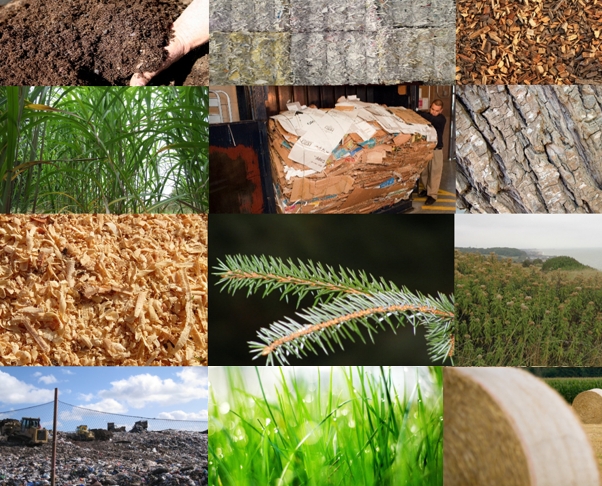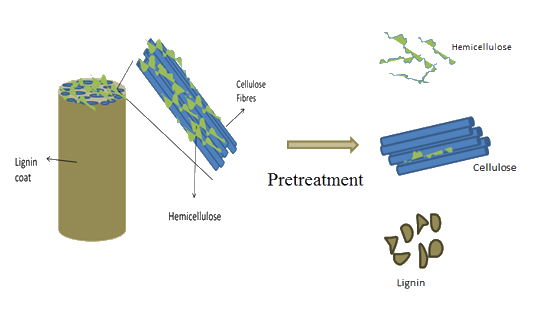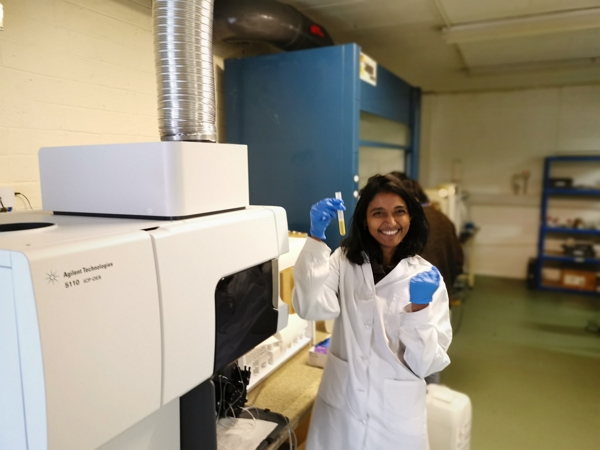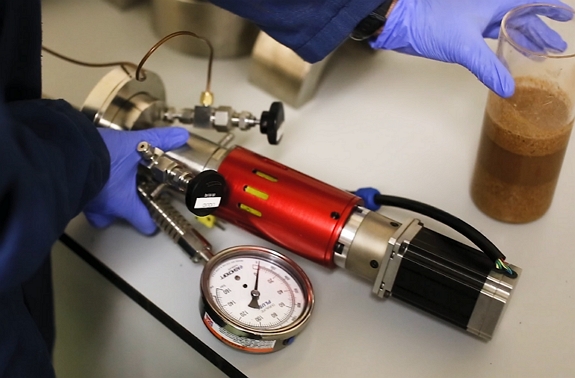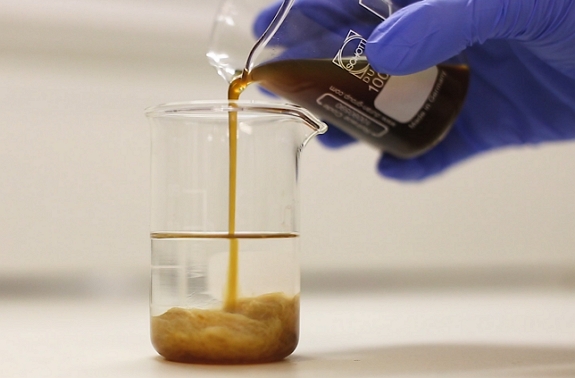Steam Pretreatment and Steam Explosion Pretreatment of Biomass
Background
Lignocellulosic Biomass
Lignocellulosic biomass is defined as a plant, or plant-derived, material that is mostly composed of cellulose, hemicellulose, and lignin. Lignocellulosic feedstocks are highly abundant, covering many biomass types including grasses, wood, energy crops (e.g. Miscanthus and coppices), agricultural residues (e.g. straws and corn stover), and municipal wastes.Lignocellulosic feedstocks are highly abundant and can often be sourced sustainably, at low cost, without leading to land-use conflicts. As a result, there is currently great interest in obtaining chemicals, fuels, and biomaterials from such biomass.
However, the hydrolysis of lignocellulosic polysaccharides is not easy and is influenced by the complex inter-associations between hemicellulose and cellulose and between these polysaccharides and lignin in the lignocellulosic matrix. In particular, the crystalline nature of much cellulose and the existence of a physical barrier of lignin surrounding the cellulose fibres are said to be major contributors to the recalcitrance of cellulose.
The mechanism of hydrolysis is further complicated by the fact that different process intensities are required for the hydrolysis of cellulose versus hemicellulose. The more intense conditions required for cellulose hydrolysis may degrade the sugars hydrolysed from hemicellulose (to products such as furfural and formic acid).
For this reason, most hydrolysis technologies employ pre-treatment processes that aim to break apart the matrix (and in particular the associations between lignin and cellulose), reduce cellulose crystallinty, and hydrolyse hemicelluloses, hence separating the hydrolysate from cellulose which can then undergo more severe/targeted treatment.
Get more info...Biomass Hydrolysis
Need for Pretreatment
For this reason, most hydrolysis technologies employ pre-treatment processes that aim to break apart the matrix (and in particular the associations between lignin and cellulose), reduce cellulose crystallinty, and hydrolyse hemicelluloses, hence separating the hydrolysate from cellulose which can then undergo more severe/targeted treatment.Get more info...Pretreatment Homepage
Steam Pretreatment (and Steam-Explosion Pretreatment) of Biomass
In steam pretreatment the lignocellulosic biomass is exposed to high-pressure steam with the temperature and pressure maintained for a specified duration, depending on the biomass type and the desired outcome. The action of steam at high pressure disrupts the lignocellulosic structure, partially hydrolyzing the hemicellulose component into simpler sugars and breaking the lignin seal that surrounds the cellulose fibres. This makes the cellulose more accessible for subsequent enzymatic hydrolysis, where cellulose is broken down into glucose.
The difference between steam pretreatment and steam-explosion pretreatment is that the latter involves a rapid decompression step that physically disrupts the biomass structure.
Steam pretreatments can take place uncatalysed or catalysed with dilute sulphuric acid. Additionally, ammonia fibre explosion (AFEX pretreatment) substitutes liquid ammonia for steam.
Effects of Different Steam Pretreatment Process Conditions
- Temperature and Pressure - These two factors are directly related as per the principles of thermodynamics. Higher temperatures and pressures generally lead to more effective disruption of the lignocellulosic structure, leading to greater cellulose accessibility. However, excessively high temperatures may lead to the degradation of some sugars, particularly the more labile hemicellulose-derived sugars, into undesirable and potentially inhibitory compounds like furfural and hydroxymethylfurfural (HMF). It can also lead to the formation of more lignin-derived phenolic compounds, which can also be inhibitory to subsequent enzymatic and microbial processes.
- Duration - The length of the steam treatment also plays a significant role. Longer exposure times at the set temperature and pressure may result in more thorough hemicellulose hydrolysis and cellulose exposure. However, similar to higher temperatures, longer treatment times can also lead to higher levels of sugar degradation and the production of inhibitory compounds.
- Explosive Decompression - This is a unique step in the steam explosion process. The severity of the explosion (i.e. the extent of the pressure drop) can impact the degree of biomass disruption and the resulting composition.
Feedstock Considerations in Steam Pretreatment
- Extractives - The content and composition of the extractives is important in steam pretreatment for several reasons. For example, some extractives might create a protective layer around the biomass, reducing the effectiveness of the steam pretreatment process by acting as a barrier to the steam. Additionally, some extractives can degrade under the high temperatures used in steam pretreatment and so form compounds that are inhibitory to subsequent enzymatic hydrolysis or fermentation processes. These degradation products can also cause issues with equipment fouling and corrosion.
- Hemicellulose Type - The type of hemicellulose can influence how readily it is hydrolyzed during steam pretreatment. For instance, xylans tend to be more readily hydrolyzed than mannans. A major reason why this is the case is that xylans contain acetyl groups. During steam pretreatment, these acetyl groups can be cleaved off, releasing acetic acid. This can acidify the pretreatment solution, which can help to catalyze the hydrolysis of hemicellulose. However, too much acetic acid can lead to inhibition of subsequent enzymatic hydrolysis and fermentation.
- Lignin Type - The composition of lignin, particularly the ratio of syringyl (S), guaiacyl (G), and p-hydroxyphenyl (H) units, can influence the outcomes of steam pretreatment. For instance, biomass with a higher S/G ratio (like hardwoods and some grasses) tends to be easier to pretreat than biomass with a lower S/G ratio (like softwoods).
Advantages of Steam Pretreatment
- Efficient Hemicellulose Hydrolysis - Steam pretreatment is effective in hydrolyzing the hemicellulosic fraction of biomass into soluble sugars.
- Enhanced Enzymatic Digestibility - By breaking down the complex structure of lignocellulosic biomass and partially removing or redistributing lignin, steam pretreatment enhances the accessibility of cellulose to enzymatic hydrolysis.
- No Chemical Requirement - Steam pretreatment is often referred to as "autohydrolysis". The lack of cehmical use (compared to some other types of pretreatments) can lead to cost savings and a more environmentally friendly process.
- Flexibility - Steam pretreatment can be applied to a variety of types of biomass, making it a flexible option for biorefineries dealing with different feedstocks.
- Scalability - The process is relatively easy to scale-up for industrial applications, which is an important consideration for commercial biorefinery operations.
- Potential for Energy Recovery - The high-pressure steam used in the process can potentially be recovered and reused, improving the overall energy efficiency of the process.
Disadvantages of Steam Pretreatment
- Formation of Inhibitory Compounds - One of the main challenges with steam pretreatment is the formation of inhibitory compounds, such as furfural and hydroxymethylfurfural (HMF), which are degradation products of sugars, as well as various lignin-derived phenolic compounds. These compounds can inhibit subsequent enzymatic hydrolysis and fermentation processes.
- Incomplete Lignin Removal - Steam pretreatment may not effectively remove or redistribute all the lignin present in the biomass. The remaining lignin can limit the accessibility of cellulose to enzymes in subsequent hydrolysis steps, reducing the overall efficiency of sugar release.
- Energy Requirement - The process requires substantial amounts of energy to generate the high-pressure steam.
- Equipment Requirements - The high pressures and temperatures used in steam pretreatment require robust and often expensive specialized equipment. Also, operation at these conditions might lead to quicker wear and tear of the equipment, increasing maintenance costs.
- Optimization for Different Biomass Types - While steam pretreatment is generally applicable to many different types of biomass, each type might require different pretreatment conditions for optimal results. Therefore, when changing between different feedstocks, the process may need to be re-optimized.
Steam Pretreatment Bioprocess Development at Celignis
Our initial step would involve learning from you what your targets are for the pretreatment and what the subsequent stages of the process, and final products, should be.
Then we would undergo a detailed compositional analysis of the feedstock in order to gain an understanding of its suitability for steam pretreatment and to consider appropriate process conditions.
There would be detailed analysis of the liquid and solid outputs of these pretreatments, comparing these results with the targeted aims of the pretreatment and downstream valorisation.
If there are also plans for downstream valorisation of the liquid fraction we can also assess the suitability of various hydrolysates from the DoE for such processes.
The commercial viability of pretreatment is particularly important and should be considered throughout the project. We usually recommend to our clients that we undertake interative techno-economic analyses (TEA) at various stages of the bioprocess development, so that the experimental and scale-up work are framed in a commercially-relevant context.
Get more info...How our Bioprocess Projects Work
Other Types of Biomass Pretreament
Get more info...Mechanical Pretreatment
Get more info...Hydrothermal Pretreatment
Get more info...Acid Pretreatment
Get more info...Acid Pretreatment
Get more info...Organosolv Pretreatment
Get more info...Other Pretreatments
Get more info...Pretreatment Homepage
With regards to the pretreatment of biomass, the Celignis Bioprocess team members with the most experience in undertaking such projects are listed below. Feel free to contact them to discuss potential projects.

Lalitha Gottumukkala
Founder of Celignis Bioprocess, CIO of Celignis
PhD
<p style="text-align: left;">Has a deep understanding of all biological and chemical aspects of bioproceses. Has developed Celignis into a renowned provider of bioprocess development services to a global network of clients.</p>

Oscar Bedzo
Bioprocess Project Manager & Technoeconomic Analysis Lead
PhD
<p style="text-align: left;">A dynamic, purpose-driven chemical engineer with expertise in bioprocess development, process design, simulation and techno-economic analysis over several years in the bioeconomy sector.</p>

Dan Hayes
Celignis CEO And Founder
PhD (Analytical Chemistry)
<p style="text-align: left;">Dreamer and achiever. Took Celignis from a concept in a research project to being the bioeconomy's premier provider of analytical and bioprocessing expertise.</p>


